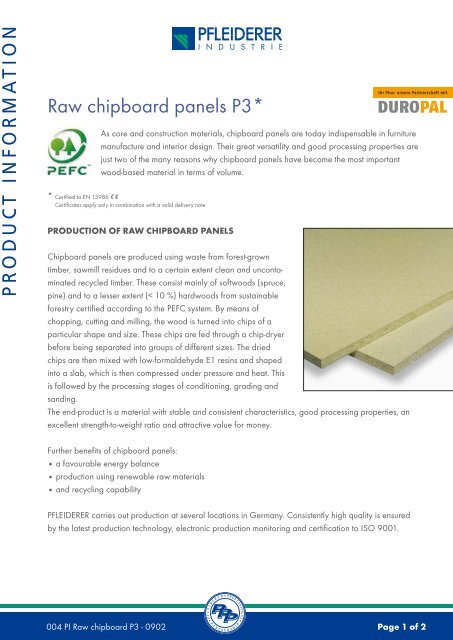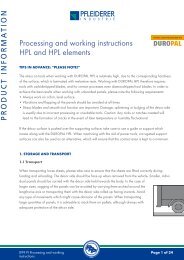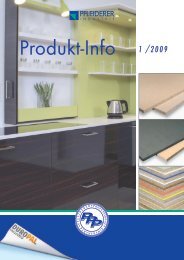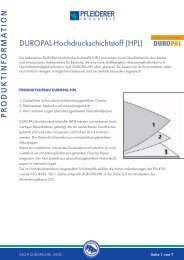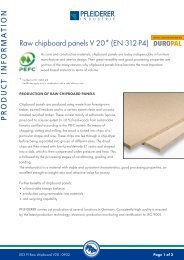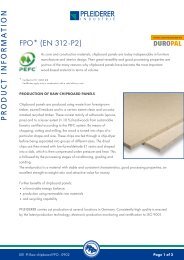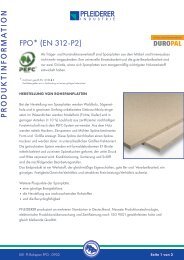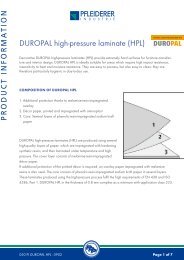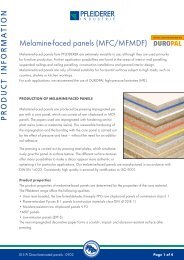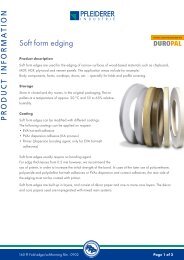PR ODUCT INF ORMA TION Raw chipboard panels P3*
PR ODUCT INF ORMA TION Raw chipboard panels P3*
PR ODUCT INF ORMA TION Raw chipboard panels P3*
Create successful ePaper yourself
Turn your PDF publications into a flip-book with our unique Google optimized e-Paper software.
<strong>PR</strong><strong>ODUCT</strong> <strong>INF</strong><strong>ORMA</strong><strong>TION</strong><br />
<strong>Raw</strong> <strong>chipboard</strong> <strong>panels</strong> <strong>P3*</strong><br />
As core and construction materials, <strong>chipboard</strong> <strong>panels</strong> are today indispensable in furniture<br />
manufacture and interior design. Their great versatility and good processing properties are<br />
just two of the many reasons why <strong>chipboard</strong> <strong>panels</strong> have become the most important<br />
wood-based material in terms of volume.<br />
* Certified to EN 13986<br />
Certificates apply only in combination with a valid delivery note<br />
<strong>PR</strong><strong>ODUCT</strong>ION OF RAW CHIPBOARD PANELS<br />
Chipboard <strong>panels</strong> are produced using waste from forest-grown<br />
timber, sawmill residues and to a certain extent clean and uncontaminated<br />
recycled timber. These consist mainly of softwoods (spruce,<br />
pine) and to a lesser extent (< 10 %) hardwoods from sustai nable<br />
forestry certified according to the PEFC system. By means of<br />
chopping, cutting and milling, the wood is turned into chips of a<br />
particular shape and size. These chips are fed through a chip-dryer<br />
before being separated into groups of different sizes. The dried<br />
chips are then mixed with low-formaldehyde E1 resins and shaped<br />
into a slab, which is then compressed under pressure and heat. This<br />
is followed by the processing stages of conditioning, grading and<br />
sanding.<br />
The end-product is a material with stable and consistent characteristics, good processing properties, an<br />
excellent strength-to-weight ratio and attractive value for money.<br />
Further benefits of <strong>chipboard</strong> <strong>panels</strong>:<br />
• a favourable energy balance<br />
• production using renewable raw materials<br />
• and recycling capability<br />
PFLEIDERER carries out production at several locations in Germany. Consistently high quality is ensured<br />
by the latest production technology, electronic production monitoring and certification to ISO 9001.<br />
004 PI <strong>Raw</strong> <strong>chipboard</strong> P3 - 0902 Page 1 of 2
<strong>PR</strong><strong>ODUCT</strong> <strong>INF</strong><strong>ORMA</strong><strong>TION</strong><br />
The following data apply for all raw <strong>chipboard</strong> <strong>panels</strong><br />
Construction materials class<br />
Emission class E1<br />
Heat conductivity 0.13 W/mK<br />
Moisture content on delivery ex-factory 9 ± 3 %<br />
Thickness tolerance for finished <strong>panels</strong> ± 0.3 mm<br />
Length/width tolerance for standard <strong>panels</strong> ± 5 mm<br />
Perpendicularity tolerance 2 mm/m<br />
Edge straightness tolerance 1.5 mm/m<br />
Outside monitoring of production by the WKI.<br />
B2 (normally inflammable),<br />
except for Pyroex B1 (low inflammability)<br />
All the above technical properties apply exclusively for normal climatic conditions (temperature, air humidity, light etc.).<br />
<strong>P3*</strong> (EN 312-P4) – the moisture-resistant material for lamination<br />
P3 is a wood-based material for structural use for non-supporting purposes. Due to the use of aminoplast<br />
adhesives, this wood-based material is resistant to high air humidity and suitable for lamination with foils,<br />
veneers, melamine-resin-impregnated decorative papers and DUROPAL high-pressure laminates (HPL).<br />
The bonding agent produces a light-coloured wood-based material which also withstands short-term high<br />
exposure to moisture.<br />
Mechanical and physical properties<br />
Properties<br />
Thickness in mm<br />
8 10 13 16 19 22 25 28 38<br />
<strong>Raw</strong> density in kg/m 3 720 700 680 670 650 650 650 640 610<br />
Bending strength (EN 310) in N/mm 2 15 15 15 14 14 12 12 11 9<br />
Transverse tensile strength (EN 319) in N/mm 2 0.45 0.45 0.45 0.45 0.45 0.40 0.40 0.35 0.30<br />
Module of bending elasticity (EN 310) in N/mmm 2 2,050 2,050 2,050 1,950 1,950 1,850 1,850 1,700 1,550<br />
Resistance to delamination (EN 311) in N/mm 2 14 14 14 14 14 13 13 13 12<br />
Transverse tensile resistance to boiling (EN<br />
1087-1) in N/mm²<br />
0.09 0.09 0.09 0.08 0.08 0.07 0.07 0.07 0.06<br />
P3 <strong>panels</strong> are manufactured in accordance with EN 312.<br />
All values correspond to the status of our production and are guideline values. Subject to amendment.<br />
* Certified to EN 13986<br />
A service of<br />
PFLEIDERER Industrie GmbH • Product Management<br />
Holzstraße 6 - 10 • D-33332 Gütersloh • Telephone: 0 52 41 / 8 71 - 0 • Telefax: 0 52 41 / 8 71 - 9 87<br />
e-mail: produktmanagement@pfleiderer.com • Internet: www.industrie.pfleiderer.com<br />
004 PI <strong>Raw</strong> <strong>chipboard</strong> P3 - 0902 Page 2 of 2


